► BMW’s i4 promises proper e-performance
► How can it compare to Munich’s own M4?
► And what about our EV class favourite, the Model 3?
What would Kimi Räikkönen do?
Scudding through a fast, fourth-gear right-hander (though technically the BMW I’m driving only has one gear), I find myself eyeball-to-eyeball with a great blue-grey smokescreen at least as wide as the circuit itself. In a heartbeat the extent of my forward visibility drops to the end of the i4 M50’s bluff nose. Has he spun? Has the twin-turbo straight-six in the car up ahead let go in a geyser of hot oil, turbine shrapnel and immaculately engineered alloys? Should I lift, or brake even? Or should I do what Kimi famously did when presented with the same (albeit far faster) scenario at Spa: keep my foot so flat to the floor the telemetry won’t show so much as a sniff of a lift? After all, CAR’s James Taylor, up ahead in the M4 Competition, knows what he’s doing, as do the fine people who engineered his car.
Sure enough, the flying i4 M50 – the first BMW EV to look anything like an M car – punches out of the choking curtain of atomised Michelin just in time to see James tease the M4’s playful rear axle back into line. Moments later he hurls the coupe’s nose at the next apex, gently slewing tail helping him rotate the car and gap me once again.
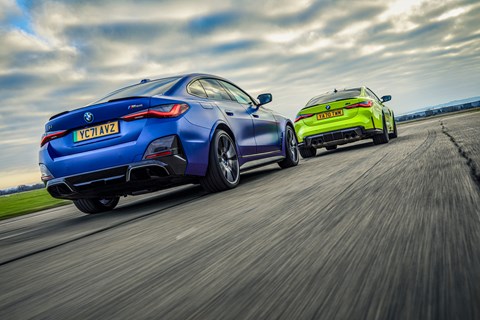
Are we having fun yet? Certainly James would seem to be – the great arcs of hot rubber on the tarmac bear testament to that. But while the i4 and I are lapping almost as quickly, so mighty are the electric car’s traction, lateral adhesion and straight-line performance, if there’s a naughty side to this BMW I’m struggling to find it. There are no graceful slides here, no straight-six-as-paintbrush expressions of man-machine harmony etched onto the asphalt. In fact, there’s precious little to suggest the car’s enjoying this kind of driving at all.
Read our BMW i4 review
After a couple of steady laps to cool our brakes we to turn off the circuit, gummy tyres chewing on loose grit as fans whir. Grinning like the Joker, James drops his window: ‘Honestly, it’s a miracle. Like the M5 CS I drove last year, this thing’s proof that M’s engineers are wizards. It’s fast but so friendly too; so exploitable – witchcraft.’
With 50 years of mostly bewitching cars behind it, M division finds itself in need of a miracle now more than ever. Electrification is coming – of course it is – and it’s bringing with it questions so challenging Paxman would blush. How to deliver an authentically M power-to-weight ratio when EVs are intrinsically hefty? How should an M car feel when, for the first time since the outlier, mid-engined M1, it doesn’t have an engine in its nose and a propshaft spinning beneath your elbow? How to immerse the driver in what M boss Frank van Meel describes as the driver/vehicle/road feedback loop when, in terms of sound and feel, the powertrain is fundamentally numb?
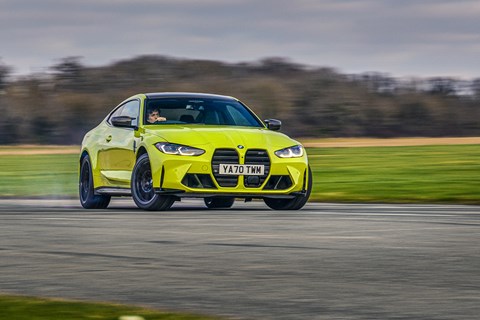
By its own admission M doesn’t yet have all the answers. It also doesn’t have much time in which to find them. The first M-badged EV will be with us around the middle of the decade. By 2030 you’ll no longer be able to buy an M car with a combustion engine. And this M4’s replacement – the very next car in a bloodline that stretches back to the E30 M3 of the ’80s – will coax its rear axle sideways not with the power and torque of flailing pistons and whirring turbos but with spinning armatures, humming inverters and the torque-rich surrealism of near-silent electric power.
And just as he admits that M doesn’t yet have all the answers, Frank van Meel is also clear that giving ground simply isn’t an option. Every car he signs off must drive like an M car and be even better than its predecessor. The first electric M cars will be cut no slack.
What of the here and now, then? M division may not yet offer an electric car but BMW does, the i4 M50, a car so relevant to the celebration of M’s 50th anniversary that it’s even badged thus… Comparisons with the M4 Competition are at once fascinating and misleading. The electric newcomer is more powerful (537bhp versus 503bhp), less expensive (£64k versus £73k) and, from 0-62mph at least, every bit as violent (3.9sec, though option your M4 with xDrive and its increased traction will drop that to 3.5sec).
Read our BMW M4 long-term test review
This, we have to assume, is the best electric car BMW can build right now. Can it hope to put the M4 Competition in the shade, a car with a full 50 years of evolution behind it? And what can its bid to do so tell us of the scale of the challenge facing M division, one that right now looks comparable to the one Kennedy set NASA in the summer of ’61 – to land a man on the Moon and return him safely to Earth before the end of the decade?
Along for the ride is the benchmark Tesla Model 3 Performance. For as important as the i4 M50’s implications for BMW are, we also need to know where the i4 ranks as a contemporary EV. Because as an M fan right now, waiting for Frank and his team to work miracles, these are your options: stick (with straight-six power), twist (to the closest thing we have to an electric M car) or fold (and go hang out with Elon for a couple of years).
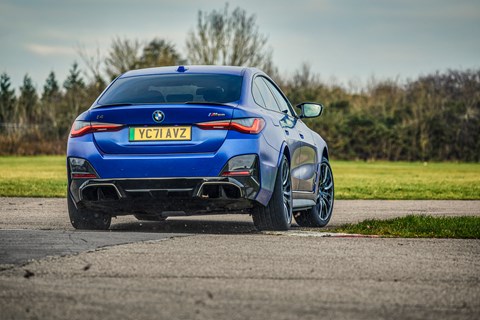
That the i4 M50 is no trackday weapon will come as news to no one – your eyes tell you as much long before you drive it. There’s simply too much to the i4 (at a shade over 2.2 tonnes, it’s some 400kg heavier than the itself-not-light M4). And while the Competition looks every bit the road-legal GT3 racer, body hung low between big, saucily-cambered wheels, the i4 M50 features no such expressions of dynamic ambition.
But jump in and it’s the i4 that’ll have you swearing out loud in amazement. (Our M4’s optional carbon-backed M buckets might have you swearing out loud too, but it’ll likely be at the complexity of the on-boarding process, at least until you master the art.) Like the bigger, 300kg heavier iX SUV, the i4 gets BMW’s new Operating System 8 and its Curved Display screens. Visually spectacular, gorgeous graphics rendered in breathtakingly high resolution, the combination of vivid, generous display and familiar iDrive interface is a hugely powerful one. Because the screen’s nearly as big as a Tesla’s you instinctively prod at it initially. Then, just as that grows a little frustrating, as touch always does, you remember the iDrive controller (and effective voice control, complete with animated on-screen avatar like a cute version of the black cloud from Fred Hoyle’s novel of the same name) and breathe a sigh of relief. (You’ve no recourse to a clickwheel in the Model 3.)
It doesn’t take long to configure the i4 to your liking. While Eco Pro and Comfort will be the distance traveller’s friend, we’ve an M4 to battle. Sport Boost is the one you want, since it gives the car permission to compromise range and efficiency in the name of outright performance (though, like most BMWs on sale, the steering’s unhelpfully heavy in the feistier modes). Key too is switching the regeneration strategy from Adaptive to something fixed, likely Medium. Adaptive, which looks at a raft of information before deciding whether to harvest (comparable to gentle braking) or coast, might well be your best bet when range (officially 318 miles; 220 on the dash with a full charge in winter) is looking tight. It’s a curveball the rest of the time, though, given you’ve no idea what the car will do when you come off the throttle. Medium brings consistency, and enough forward weight transfer to help pin down the i4 M50’s front axle (handy, given understeer is plentiful if you’re ambitious on corner entry).
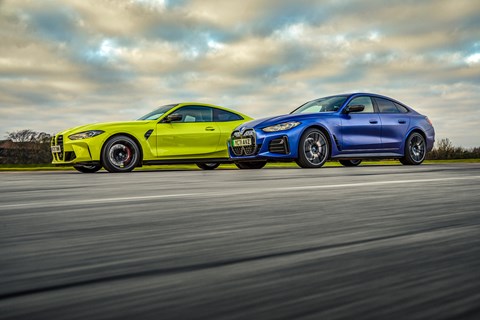
Thus configured, you head off. Perhaps, like me, it’ll be a journey you know well, and that almost always takes 20 minutes. And perhaps, as happened with me in the i4, you’ll be a full four minutes faster than you’ve ever been before (though consumption will drop from circa 2.8 miles per kWh to 2.1 as a result) – and this in weather that’d see an F1 race cancelled and points controversially awarded on yesterday’s performance in qualifying.
On the road, the electric BMW is magnificent. On track, even as it does a great impression of a 2.2-tonne fish out of water, the i4 M50 shows some class. There’s the sense of finely judged suspension working in harmony with an ultra-rigid structure (the i4 gets no i3- or iX-style composites, but it feels milled from solid after the slightly flimsy Tesla), of accurate if not particularly quick or tactile steering, and of deftly calibrated controls (where the Tesla’s throttle response is adjustable between slovenly and hyperactive, the i4’s is – almost regardless of drive mode – just right). And on the road it all comes together in a car of quite surreal pace and composure. There’s mid-corner poise, there’s grip – lots of grip – and there’s a clearly communicated limit up to which it’s easy to nuzzle. While there’s nothing to be gained from broaching those limits, there’s real satisfaction to be had in working with the i4’s prodigious talents to uproot most of your reference points and gleefully drag them off into the middle distance.
Traction is nonsensically, hilariously complete. Wet road? Doesn’t matter. Cold tyres? Doesn’t matter. All the right-foot sensitivity of a DPD driver? Doesn’t matter. The i4 just hauls, even if it never feels as viciously accelerative as the Tesla. (It isn’t. The 505bhp Tesla is over half a second faster 0-62mph, and this despite BMW’s much-vaunted fifth-gen motors. Perhaps they’ve more in reserve, or maybe BMW’s fearful of unleashing full EV weirdness; certainly the i4 is way more of a conventional car than is the challenging, disruptor-shaped Model 3.) The i4 M50, like the combustion-engined M440i or M850i, is the terminator in the first film – humourless, unstoppable. It’s impressive as a refined and high-speed, relatively low-effort conveyance, but the driving experience feels childishly easy, like a video game. With no perceived jeopardy there’s little reward, either. At one point I leap a humpback bridge with my foot to the boards just to feel some wheelspin; to feel something; to feel alive.
The M4 Competition, by contrast, is Arnie in Terminator 2: Judgment Day – still an unstoppable weapon of terrific power and cunning , but one that’s now inexplicably cuddly, has a sense of humour and is genuinely great company. In setting itself the admirable target of eclipsing each M car with its successor, M division has, with the phenomenal G82 M4, stitched itself up royally. The most complete, capable and charismatic M3/M4 to date (previous M3/M4s, cars like the E46 CSL and F82 GTS and CS, have delivered higher highs but not in base guise), this thing has, since launch, seen off everything we’ve thrown at it, from Porsche 911s to AMGs, Alfas to RS Audis, and come up short only once, when Cup tyres met a wet track.
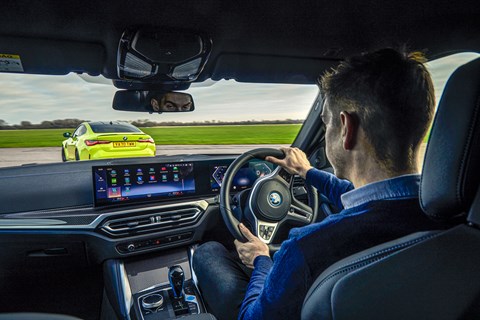
Climbing into the M4 from the i4 is like going from fumbling in the gloom to someone switching on the lights. Whether you’re pushing hard or just popping to the shops the front axle is key to the driving experience. With a wide track width, some meaty camber angles and kinematics inspired by the CS version of the previous-generation M4, the BMW’s nose is your best friend; grippy, feelsome and the very solid foundations upon which the M4 builds the rest of its unexpectedly tactile driving experience (with 503bhp, point-and-squirt would been a valid option).
Turn the wheel and you feel everything, like the front axle is somehow in your hands. (It helps too that you sit lower than you do in the i4; in the car rather than on top of it, your brain closer to the action.) And from there the poise and delicacy of the chassis, not to mention the crisp, almost lag-free responses of the engine, mean a world of deft adjustability opens up before you. The car responds to the slightest shift in load across its axles, from a little deliberate front-end loading through a wet corner on the road, to test the available grip, right through to wonderfully lurid and expressive drifts on a circuit, the M4 apparently (and usefully…) just as keen to help you neatly gather the tail back up as it is to help you send it wide in the first place.
But there’s so much more to this M4 than hooliganism. While some interpret its duality as a lack of focus, the truth is M cars have always conducted their business this way: the best of both worlds; road cars with a little motorsport DNA rather than road-legal racers.
Yes, the Competition is eye-wateringly rapid at ten-tenths. But it’s nearly as exciting and rewarding at six-tenths. When you just need to go somewhere it’s an awesomely luxurious, well-appointed and effortless ally, the only flies in the ointment the 28mpg thirst and the road noise from the huge Michelins. And the point is, when you do find yourself on a great stretch of road, there’s no need to pop home for your ‘fun car’ – you’re already in it.
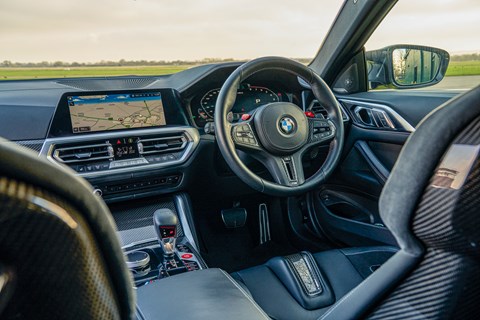
The good stuff just keeps on coming. Traction, even on our rear-drive test car (the xDrive M4 is on sale now), is unbelievably strong, even in winter. The auto transmission is a silky smooth operator at all speeds, and shifting manually – either via the paddles or the stubby little forward-for-down, tug-for-up lever – a key part of the M4 experience. So deft is the damping that Sport’s more than tolerable on the road, with Comfort a good fall-back when nan’s onboard. The infotainment, while a generation behind the i4’s, works beautifully. And the M1 and M2 buttons on the steering wheel, to which you can tether all your preferred settings, remains one of the best methods by which to streamline deep customisation possibilities (the i4 could really use them), and a swift and convincing counter to the accusation that M offers too much choice. Why risk any aspect of the car not being to your liking when you can, thanks to M’s myriad options, try them all out, set your presets and then live happily ever after?
But for all the M4’s myriad strengths, its greatest achievement is the confidence it’s able to instil in you, the driver. So tactile is it as a driving tool, and so accessible does it make 503bhp, that you’re soon into a virtuous circle of giving more to get more, the car rewarding your efforts with a bigger smile and higher high every time you drive it. As M’s development boss Dirk Hacker puts it: ‘It is very important that a normal customer is able to go nearly as fast as our experts.’ Dirk, on behold of normal customers everywhere, vielen Dank.
Clearly then, M has a mountain to climb. It’s managed miracles before, of course. It’s steamrollered race series at the first time of asking, won F1 titles with road-car engines and introduced potentially heretical technology without so much as a murmur. But it’s never faced a challenge like this one. Good luck, Garching.
i4 vs Tesla Model 3
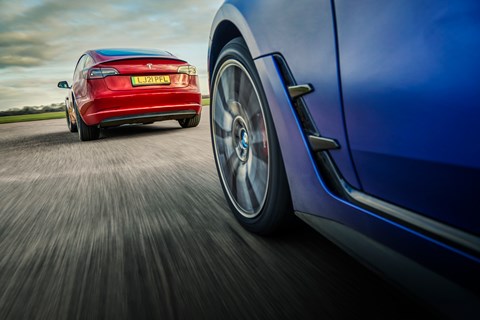
If one of the things stopping you going electric is the way many EVs take a wilfully weird approach – in look, feel and user experience – then the i4 is resolutely, comfortingly normal. And in many ways, that’s a strength. You start it with a button. It operates largely like a regular car: no alarms, no surprises.
Tesla’s iconoclasm demands you change your mindset: the absence of a conventional instrument panel, or means of starting the car (just climb in, put it in ‘gear’, drive away); the way practically every function is via the touchscreen (from adjusting the steering wheel to unlocking the glovebox); its set-up as entertainment centre on wheels, with built-in Netflix and arcade games. As slick as the i4’s iDrive system is, the Model 3 is a car you’d consider owning for its operating system as much as how it drives.
But you must buy into that OS totally. The screen demands your attention, all the time. Even when conscientiously keeping your eyes on the road, they’re constantly dragged back to that 15-inch information portal centre-stage.
The BMW feels better built. Not a surprise. But this is a surprise: the Tesla’s more fun than the BMW. It’s not only preposterously fast in a straight line (in a way that pins you to the oddly shaped headrest) but the lack of bodyroll and the quick steering make it a laugh in corners. The i4 has better steering feel than the Model 3, keeping you more in touch with what’s going on. But it’s a shame the i4 doesn’t seem keen on you being involved. For a BMW, it’s a bit inert; safe and unspectacular.
If it’s involvement you seek the more affordable, lighter (by 165kg), single-motor and rear-drive 40 is the sweeter i4 to drive. It’s more playful, more like a traditional sporty BMW, with a rear-driven nature and more on-paper range, too. By the same token, I’d choose a Model 3 Long Range model over a Performance; the latter’s 20-inch wheels make for a lumpy ride and the £10k-cheaper Long Range is still absurdly rapid.
Right, off the electric fence. Which one? Tough call; the i4 is lovely to drive on the road, and soothing to live with. It’s an easier car to adapt to. The Tesla is a true disruptor. It’s more divisive and its screen-is-all interface fixes some things that weren’t broken. But the Model 3 is the bigger step forward for car-kind and the more desirable product overall.
Read our Tesla Model 3 review
Tesla Model 3 vs BMW M4
This isn’t a fair fight, of course, but the sloping playing field advantages both cars in different ways. The M4 has a chassis and powertrain honed by decades of M division know-how, and it isn’t weighed down by a battery pack. But the Model 3’s electric powertrain gives it astonishing firepower: its fast-twitch hit of instant torque makes the Tesla feel more like a ground-level Space X projectile than a humble car. Even after the M4 in full flight, the Model 3 feels absurdly quick.

The Tesla isn’t out of its depth on track either, though it lacks a little polish when pushed hard. The fast-racked steering’s a bit quick for its own good, and the Model 3’s stability control can be outfoxed more easily than the BMW’s. Or turned off deliberately: the Model 3 Performance includes a Track Mode, with sliders to let you adjust your front/rear power split. Presets include a Race mode for quick lap times and a Drift mode.
But whether you’re on road or track, the Tesla can’t touch the BMW for adjustability, tactility and sheer driving thrills. The M4, from its suspension through its differential to its sculpted torque curve, is beautifully calibrated. It delivers scarcely credible levels of driver confidence. The Tesla doesn’t hit the same highs. But it gets far closer than it has any right to.